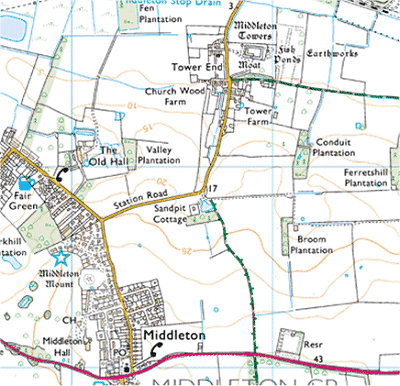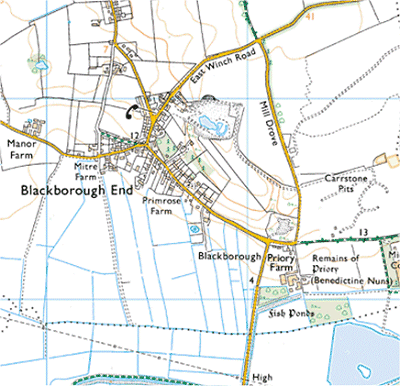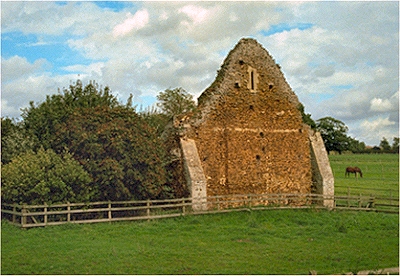| The
Middleton/Rivenhall Line and its Origins |
| The
most historically significant branch of the
Scales family is that deriving from Roger de
Scales born in 1098. He is thought to be a
descendant of Hardwin de Scalers but the precise
nature of the relationship is not known for sure.
This branch of the family adopted the same coat
of arms, a scallop shell motif with no motto (our
site logo), as the Reed/Whaddon branch, whereas
the arms of the Shelford/Caxton branch were
different. However, they always seem to have used
the present form of the surname. I am going to
suggest (no more) that he was the son of Hugh de
Scalers and therefore grandson of Hardwin. The
dates seem reasonable, but there is always the
possibility that he connects to the family
further back. |
| Roger
first appears in Middleton, near King’s Lynn
in Norfolk, during
the reign of Henry II (c.1160), married to Muriel
de Lisewis. He acquired from her a number of
domains in Norfolk (including Middleton itself)
that she had co-inherited with her brother
Geoffrey from Hugh de Montfort. After Muriel's death,
Roger married Agnes de Rivell, heiress of the
Manor of Worlington in Suffolk, thus extending
his lands to the south. He was the founder the
Middleton/Rivenhall branch of the family, which eventually came through
marriage to reclaim the Manor of Newselles and
title Lords of Newselles. The family tree
of the Middleton/Rivenhall Scales line is shown
as far as it is known at the bottom of the page. |
| Middleton
was the main seat of this branch of the Scales
family for four generations, on the site that is
now Middleton Towers but was originally
the manor house called Scales Hall. Very
little is left of the early dwelling except for
the moat, the remains of some fish ponds and some
other earthworks (see later on this site). When
the 3rd Robert Scales married in 1255, he
acquired the Manor of Rivenhall in Essex, which
became the main seat of the family for the next
seven generations until Thomas, 7th Baron Scales,
moved back to Middleton and commenced the
building of Middleton Towers. |
| Blackborough Priory and St.
Mary's Church |
| Roger
de Scales and Muriel de Lisewis founded the
Priory of St. Mary and St. Catherine, later known
as Blackborough Priory in about 1150.
The Priory was originally intended to house
monks, but soon after its foundation it admitted
nuns as well. In 1200 it became a Benedictine
nunnery and remained as such until the
Dissolution of the Monasteries in 1538. The ruins
are still there: the probable south wall of the
church, the gable end of another substantial
building and the north gable and part foundations
of a smaller building. Dense spreads of building
materials mark the sites of other buildings
attached to the Priory and the earthworks of five
mediaeval fishponds have been recorded. |
| St.
Mary’s Church in Middleton was also founded
at this time, no doubt by the Scales family;
their arms appear in a stained glass window in
the north isle and the east window of the chancel
is ornamented with scallop shells. |
| The Early Middleton/Rivenhall
Line |
| Roger’s
son Robert (1129-1198) married Alice, but little
is known of her or his brother William (b.c.1131)
except that the latter became a monk at
Blackborough Priory. Their son Roger (d.bef.1219)
married Maud. |
| Roger's
son Robert (d.aft.1235) married the heiress
Margaret (Margery) de Beaufou, daughter of Fulk
de Beaufou of Hockwold cum Wilton in Norfolk. He
had a sister Margaret (b.c.1163). Robert was
summoned to parliament in about 1205 with the
title of Lord Scales. In 1238, a Katherine
de Scales is recorded as being prioress of
Blackborough Priory, but her precise connection
to the family is unknown. |
| Robert’s
son Robert (1189-1257) married Alice de
Rochester, heiress of Sir Ralph de Rochester. The
latter at this time was holding the title Lord
of Newcells, so the estate must have
transferred by marriage. At any rate, she brought
the title back to the Scales family together with
the estates at Newselles and much more, including
Rivenhall in Essex, which became the main seat of
the family for the best part of 200 years. In
1268, after her husband's death, she arranged
that the title Lord of Newcells be passed
on to her younger son Roger (b.c.1223). In 1274
she is recorded as having recovered damages for
some of her swans being stolen at Hockwold cum
Wilton. She died shortly afterwards. |
| The
Rivenhall estate is now known as Rivenhall
Place, though nothing remains of the
original manor house following the 16th-18th
century rebuild. The church of St. Mary and All
Saints in Rivenhall was established in the early
11th century, extended in the 14th-15th centuries
and substantially remodelled in the 19th century.
|
| Robert's
eldest son Peter inherited his father's estate
but died shortly after his father in 1258. The
second son Robert (1219-1266) took over and
married Muriel de Liscuris, heiress of Jeffery de
Liscuris. On her death, seemingly without issue,
he married Clemence (Clementia), by whom he
probably had his three sons. Robert had two other younger
brothers: John (b.c.1233) and Geoffrey
(b.c.1235). He was involved in several
expeditions to France and served in Parliament.
He was serving at Dover Castle from 1261-2
alongside a mysterious Sir Radulfus de Escales. Clemence outlived him
and remarried to Sir Robert de Vaux. |
| Robert 1st Baron Scales |
| Robert
and Clemence’s son Robert (1249-1305) became
the first Baron Scales in 1299 for his services
to Edward I. He married Isabel de Burnell, niece
of Robert Burnell, Bishop of Bath and Wells, Lord
Chancellor and Treasurer of England and trusted
associate of Edward I. He had two younger
brothers: William (b.1251) and Richard
(b.c.1253). His main residence was the Manor of
Rivenhall in Essex, but he also held Middleton,
Newselles and a large amount of other land in
Norfolk, Suffolk, Lincolnshire and
Cambridgeshire. Robert fought for Edward I in the
invasions of Wales in 1276-77 and 1282-83,
finally defeating Llywelyn and Dafydd ab Gruffydd
and other Welsh chieftains. This marked the start
of the construction of the many famous castles in
Wales. |
| In
1294 he accompanied Edward to Gascony in the
unsuccessful war against France. Philip IV of
France had declared Edward’s own Duchy of
Gascony forfeit when Edward refused to appear
before him in Paris to discuss the recent
conflict between English, Gascon and French
sailors that had resulted in several French ships
being captured and the sacking of La Rochelle. In
1296, he was with the King for the invasion of
Scotland, a temporary success for the English.
This was when Edward confiscated the Stone of
Scone (the Scottish Coronation Stone) and
brought it to Westminster Abbey. In 1298 he was
in Flanders accompanying the king in seeking a
peace aggreement with Phillip IV. In 1301 he was
again with the king in his campaigns against
William Wallace in the First War of Scottish
Independence. He served in Parliament from 1299
until his death. |
| Isabel
was a great benefactress to Blackborough Priory,
where she was buried, and gave a silver chasuble
and vestments for the priests, carrying the
family arms, along with ornaments to lay over her
sepulchre on the day of her anniversary. |
| Robert 2nd Baron Scales |
| Robert,
2nd Baron Scales (c.1278-1324), was made Knight
of the Bath in 1305 by Prince Edward, whom
he accompanied in the Scottish wars and whose
coronation as Edward II he attended in 1308. His
main residence was the Manor of Rivenhall, but he
also held Middleton and numerous other estates in
Norfolk. He had two younger sisters: Isabella
(b.c.1281) and Catherine (b.c.1283). He married
Egelina (Evelina) de Courteney, daughter of Hugh,
Baron Courteney and Earl of Devon. He served in
Parliament from 1306 until his death. |
| Robert 3rd Baron Scales |
| The
2nd Baron died leaving his son Robert, 3rd Baron
Scales (1312-1370), a minor in the custody of his
mother. He assumed charge when he came of age in
1333. His main residence was the Manor of
Rivenhall, but he also held Middleton, Newcells
and a number of other estates in Norfolk,
Suffolk, Cambridgeshire and Essex. He had an
elder sister Petronella (b.1304) and three
younger siblings: Peter (fl.1330-1346), who held
the Manor of Wetherden in Suffolk, Eleanor
(1315-1361), who married John, 2nd Baron Sudeley,
and Hugh (b.c.1317). He married Catherine
d’Ufford, daughter of Robert d’Ufford,
1st Earl of Suffolk, and sister and co-heir of
William d’Ufford, 2nd Earl of Suffolk. In
1335 he was in Scotland with William
d’Ufford and in 1337 he was on the King's
Service overseas with Robert d’Ufford and
his younger brother Peter. He was campaigning on
Edward III’s behalf in Brittany in 1342 and
in Gascony in 1345. In 1346-7 he was with Edward
at the Siege of Calais, which was successful for
the English but marked the start of the Hundred
Years War. He served in Parliament from 1343
until his death. |
| Roger 4th Baron Scales |
| Roger,
4th Baron Scales (1348-1387), was born in
Newselles and assumed the title Lord of
Newcells, but his main residence was the
Manor of Rivenhall. He also had land in
Cambridgeshire. He had two elder brothers, Peter
(c.1334-bef.1370) and Robert (c.1342-bef.1370),
both of whom predeceased their father, and two
elder sisters, Elizabeth (c.1335-1367), who
married Sir Roger de Felbrigg, and Margaret
(1339-1416), who married Sir Robert Howard. Roger
married Joan de Norwood, daughter and heir of Sir
John de Norwood of Kent, and acquired further
estates in Kent and Essex through her. In 1371 he
was on an expedition to France and in 1381 was
seized by the Norfolk Rebels during the Peasants’
Revolt. He attended Richard II to Scotland in
1384 and John, Duke of Lancaster, in the Spanish
expedition of 1385. He was Commissioner of the
Peace for Cambridgeshire and Norfolk for many
years between 1373 and 1386. He died on Christmas
Day in 1387 and was buried at Blackborough
Priory, leaving his estates under the control of
his wife until his son's majority in 1394. |
| Robert 5th Baron Scales |
| Robert,
5th Baron Scales (1373-1402), held the Manors of
Rivenhall, Newselles and other estates in
Norfolk, Suffolk and Cambridgeshire. He had a
younger sister Catherine (c.1377-1438), who
married Arnold Savage of Kent. He married
Elizabeth Bardolf, daughter of William, 4th Baron
Bardolf, an extensive landowner in Norfolk,
Suffolk and Lincolnshire. Robert voted in
parliament for the safe custody of Richard II
after he was deposed in 1399 and for Henry
Bolingbroke to be crowned King Henry IV. He was Commissioner of the Peace for
Norfolk from 1399 to 1401. He died in 1402 and was buried at
Blackborough Priory. |
| Robert 6th Baron Scales |
| Robert,
6th Baron Scales (1396-1419), was only six when
his father died and was under the wardship of
Ralph, Earl of Westmoreland, until his majority.
He had an elder brother Richard (d.c.1402), who
had an estate in Wetherden, Suffolk, and seems to
have died around the same time as his father
(1402). Robert died unmarried at the siege of
Lovers Castle in Normandy, en route with
Henry V from Caen to Rouen. His younger brother
Thomas became the illustrious 7th Baron (see the
next page on this site). |
|
 |
| |
 |
| |
 |
| The
Ruins of Blackborough Priory |
| |
 |
| St.
Mary's Church, Middleton |
|